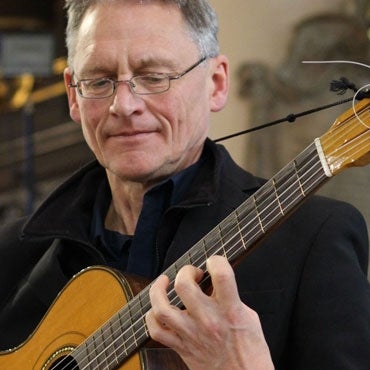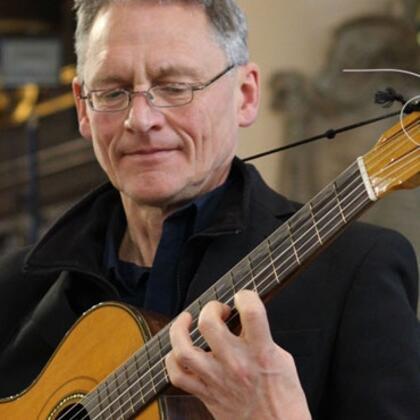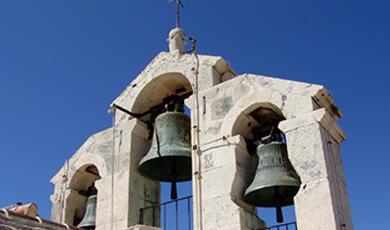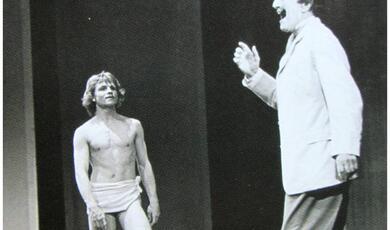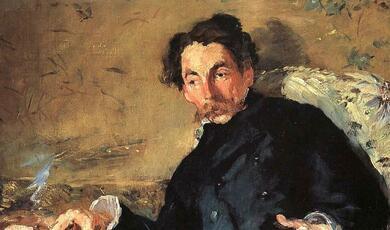Harmony in the Lowest Home: The Guitar and the Labouring Poor
Share
- Details
- Text
- Audio
- Downloads
- Extra Reading
By the 1830s, guitars could be bought very cheaply at pawnbrokers’ shops, market stalls and the humblest of the ‘musical repositories’ that sprang up in response to the spread of musical amateurism. For the first time in the history of western music, the working classes, and even some members of the labouring poor – never able to afford a piano, harpsichord or harp, but only a flute or fiddle – found themselves with a fully harmonic instrument and sometimes with ambitions to match. This development, often cruelly satirised is an unwritten chapter in the history of working-class self-improvement that comprehends the rise of the mechanicks’ institutes and the spread of working people’s access to newspapers and conversation in the urban coffee shops.
Download Text
19 February 2015
Harmony in the Lowest Home:
The Guitar and the Labouring Poor
Professor Christopher Page
Here is a story that was doing the rounds of the newspapers and periodicals in the mid 1830s:
A lady, who kept a seminary in Somers Town, was in want of a housemaid; she advertised, and many called to offer their services. The lady was pleased with the appearance of one, and entered into an agreement with her, requesting her to come to her place without delay. The girl seemed as if she had something on her mind, and, after a grand effort, she said that she would require to go out twice a week for the first month. ‘Oh! (said the lady) you attend some particular chapel, I conclude?’ — ‘No, ma’am, (simpered the girl) but I am learning the guitar, and have paid for a quarter's instruction in advance; so I should not like to lose my lessons.’
History does not record the name of this housemaid, so I cannot visit her grave and lay flowers upon it. I wish I could. How can one not admire her? Her work will be poorly paid and menial, for she will be essentially a cleaner. In the words of a contemporary manual, she will have to ‘contend against a host of enemies — dust, soot, smoke, rust, insects of various kinds, and bad smells innumerable’. Nonetheless, she has somehow found the money for guitar lessons and, at a time when the task of winning any kind of concession or indulgence from an employer required courage, easily interpreted as impertinence, she is not afraid to speak. She pays the price for it and finds herself once more unemployed in a world without a welfare state.
I would like you now to consider another guitarist within the working population. The first page of your handout shows an anonymous caricature entitled The March of Intellect from 1831. HANDOUT 1. The scene is a poor dwelling, still with the casement windows of old London, where an elderly laundress, clearly undernourished and dressed in rags, is sitting in what is perhaps the only room of her lodging. Some laundry is boiling in a pot on the range; more hangs drying beneath the stained and patched ceiling. The room is full of steam, no doubt playing havoc with the tuning of the six-string guitar she is playing. Painfully unlike the young girls in their prime who are so often associated with the guitar in contemporary engravings and portraits, she sings to her own accompaniment. The score of her song lies on the floor; it is the popular ballad My heart with love is beating, from The Siege of Belgrade, a comic opera that premiered in 1791. Nearby lies a bill advertising the ‘amateur concert’ in which she hopes to take part, with the word ‘amateur’ cruelly misspelled.
Laundry work, often done in the home then returned to the customer, was one of the most common forms of employment for relatively poor women in nineteenth-century England, and such women ranked even lower than housemaids. I would not care to say whether they did actually play the guitar in London during 1830s, or whether they took part in ‘amateur concerts’; on the face of things, I’m inclined to doubt it. A laundress was prone to various skin conditions that principally affected the hands, perhaps making performance on a musical instrument painful or impossible, to say nothing of the want of time during the day for a luxury such as music. To judge by newspaper advertisements of the period, it was male instrumentalists who dominated the amateur concerts. So what is being satirized here?
A hand-coloured lithograph of about 1840, this time showing a chimney sweep with a guitar, poses much the same question. HANDOUT 2. Entitled Music hath Charms, it shows him serenading the scullery-maid. My answer would be that these caricatures, like the story of the housemaid, respond to a development, traceable from the 1820s onwards, which involved much more than the guitar. Look again at the laundress on the first page of the handout. The title of the picture, which you can perhaps just discern at the bottom, is ‘The March of Intellect’. This phrase appears more than two thousand times in the newspapers and periodicals of the nineteenth century. The British Newspaper Archive returns more than 200 examples for the year 1831 alone, when this caricature appeared. The expression was used, often in a polemical context, to denote any aspect of progress in science or education, especially the education of the disadvantaged, which a commentator might wish to lampoon, not necessarily with malicious intent, or to ridicule. The provision of gas lamps in the public streets, evening classes for workers, liberal ideas opposed to the entrenched privileges of the grander farmers or landowners and, we might add, guitar lessons for housemaids: these were signs of the ‘march of intellect’, and could be judged very differently according to the vested interests of the observer.
In our caricature, the use of that expression is clearly ironic, for if there are signs of progress here they are certainly of the wrong kind, at least in the judgment of the artist. The washing in the saucepan on the range is boiling over so that water falls and hisses on the coals below, producing a huge plume of steam; the long spoon used for stirring the laundry is falling down to the dismay of the cat, and is about to crash down upon the bare flagstones of the floor. This is all because the woman has quite literally turned her back on her work for the performance of a love song to her guitar. It is meant to be humorous, and would not have been called in its own day, I suspect, a satirical picture. When a version was published in a newspaper it was called a ‘fancy sketch’, which sounds rather less mordant than a ‘satire’. Yet the picture is capable of a cruel and (I admit) a rather humourless interpretation. The pastime of playing the guitar is as absurd, in one so base, as the performance of a love lyric is grotesque in one so old. It is also damaging, for this is what the ‘march of intellect’ comes to: laundresses, chimney sweeps, housemaids and other members of the labouring underclass acquiring a better conceit of themselves and neglecting the menial but vital employments to which they were born. Will this not eventually lead to restlessness, to radicalism and then, perhaps, to riot?
To some, however, it seemed that the ‘march of intellect’ was virtually synonymous with the onward march of Great Britain. So we read in an issue of the The Argus, from 1828:
This begins to reveal the scope of the argument I would like to make. The guitar has an important place in the social, economic and political changes that took place in England during the first the of nineteenth century. I do not mean to imply that the guitar ever became the principal instrument of the small artisan or other working men and women: cheap fiddles and flutes or fifes, homemade or purchased from a pawnshop, or a street vendor, were just as important, probably more so; but I do wish to suggest that circumstances arose in which the guitar was uniquely able to move between all social classes in England in a way that cheap flutes and fiddles, to be distinguished from well-made and expensive violins, were not. The guitar was therefore deeply engaged with the aim of self-improvement and education among the poor: with the March of Intellect.
Who were the poor? Were the workers in the factories of the midlands and the north, the new urban proletariat, among them? Certainly, and it was no doubt on the backs of their labour that the guitar achieved its ascendancy among the mercantile gentry of the manufacturing centres like Birmingham and Manchester in the 1830s. But, and here I follow Eric Hobsbawm, ‘…the most active, militant and politically conscious of the labouring poor were not the new factory proletarians but the skilled craftsmen, independent artisans, small-scale domestic workers and others who lived and worked substantially as they had done before the Industrial Revolution, in small workshops, but under far greater pressure’. During the 1830s, evidence for the spread of the guitar among such workers begins to accumulate (our housemaid was surely one of Hobsbawm’s ‘small-scale domestic workers’) and the beginning of the decade brings what is perhaps the most important example.
In 1831, the printer Henry Hetherington began a radical weekly, The Poor Man’s Guardian, at a penny per issue, an illegal publication that advocated universal suffrage, factory legislation and trade union rights. On 13 October 1832 the newspaper advertised the reopening of a school run by a certain Mr. Wise:
As the mention of Jean-Jacques Rousseau suggests, the ambitions of Mr. Wise’s school should not be underestimated. Ability with the guitar would allow the players to carry their political convictions into many different contexts where they could, in the words of the advertisement, ‘sing correctly the rational and liberal songs now published’.
Why choose the guitar for such a school? My answer to that question would begin with a simple and appealing song that was published, with accompaniment for the guitar, in 1795. The melody was quite well known, and there is even a set of variations upon the theme by Beethoven:
A shepherd loved a nymph so fair, from Chabran’s 1795 tutor for the guitar.
In 1834, our instrument made an appearance in The Casket, one of the penny magazines, sold for about the price of a pint of beer or half an hour’s wage-labour. The editors ran a piece entitled ‘The Conveniences of the Guitar’ which they took (with acknowledgement) from the Giulianiad, the first niche magazine for guitarists in English. What was the convenience of the guitar, exactly? In addition to advantages I have often had cause to mention, such as portability, the guitar was the only cheap instrument that could provide the kind of harmonic accompaniment that you have just heard. On 17 May in that same year of 1834, The Penny magazine of the Society for the Diffusion of Useful Knowledge, a London magazine with a weekly circulation of some 200,000 at its peak, had this to say: “But if we were to recommend an instrument to be made sufficiently cheap, if possible, for the working classes of this country, it should be the guitar”. The author recommended that the difficulty of tuning could be simplified by the sale of separate tuning forks for each string (again, there is obviously no question of there being any pianos among those he has in mind), and although (I quote)
the guitar admits of very little, either of tone or execution, yet that little is what is technically called harmony; that is, proper combinations of notes can be struck at once, and in this it would be superior to the flute or clarionet, which only produces melody; that is, the simple consecutive notes which make up the air. Next, the little that an ordinary player can ever hope to do on the guitar can be soon done; a very few lessons, with a proper book of instructions, would suffice to enable the beginner to please himself and others.
It is easy to see what he means: the simple song you heard a moment ago uses no more than two harmonies, but to hear it, and to play it, is to have one’s ear grounded in patterns of harmonic instability and repose, of departure and return, that have been at the heart of Western music ever since the emergence of tonal harmony in the eighteenth century: I mean the chords of I and V, or if you prefer, and in this case, of A major and E. I would like you to hear a rather more sophisticated example straightaway. This is a setting of melody The Blue Bells of Scotland one of the vast number of lilting tunes deemed to be Irish, Scottish or Welsh and known from street to salon. Here is what the guitar could offer to players who applied themselves a little more: a clearly etched melody with a simple but effective harmonic support of primary chords:
The Blue Bells of Scotland
How would working people eager to buy a guitar find one that they could afford? Here, the role of the London coffee shops was of capital importance. I would like to read you a passage of dialogue transcribed from a government report of 1817 concerning law and order in London. The owner of a coffee shop is being asked about his trade:
Do you keep a coffee shop?
I do.
Can you inform the Committee, how long the establishment of coffee shops has been adopted ?
About five years, I believe; there were very few at that time.
From what cause did it originate?
From the cheapness of coffee; and they met with encouragement from the great convenience they afforded to working persons.
Do you furnish newspapers ?
Yes, we have four a day…we have The Times, The Ledger, and the Morning Chronicle, in the morning, and The Courier in the evening
The coffee shops were sometimes presented as miniature and ideal societies for the exchange of ideas, as in The Crisis and National Co-operative Trades’ Union Gazette, for August 2, 1835:
…the mechanics’ coffee-room is a complete little republic where warm arguments and good sense level all distinctions; and as the artisans, through being associated together in their work shops, have an opportunity of freely talking without interruption, they possess an admirable talent for conversation and debate, which many who consider themselves their superiors might feel glad to possess.
By the 1830s, working people unable to afford a subscription to a newspaper were able to read reviews of concerts, fulsome accounts of gentry music parties, notices placed by governesses offering to teach the guitar, advertisements for instruments, methods and published music, all for nothing, or rather for the price of a cup of coffee. They could also see announcements for forthcoming auctions, one of the most important ways, I suspect, in which people on the lower rungs of the economic ladder could obtain their guitars at a price within their means. All the main morning papers carried such advertisements, often giving a summary list of the main items liable to be of interest, and guitars are frequently mentioned, both in the London and in the provincial papers.
A second source of cheap instruments was the pawnshop. Charles Dickens refers to these as the ‘receptacles for misery and distress with which the streets of London unhappily abound’, but he acknowledges that some were more distinguished than others. Guitars seem to have passed in and out of pawnshops with some frequency, suggesting that members of the poorer classes, who might rely on the pawnbroker to get through the week, were acquiring them. A lute-guitar, by now surely something of an oddity, lay in the window of a Portsea pawnshop in 1827 as an unredeemed pledge, and in 1831 an essay in The Manchester Times and Gazette imagined a guitar hanging on the wall of a pawnbroker’s shop left by an impoverished apprentice to a hatmaker. The manufacture of hats was one of the most dangerous trades of the time because of the mercury used in the production of felt, whence the ‘expression mad as a hatter’ (it is no surprise that hat-makers were among the first to form a trade union). The apprentice in this case had tried his hand as a professional performer, to escape the curse of his profession, and failed. This is a sorry tale of one who hoped that the guitar would offer release from hard and dangerous labour, but found that it did not, with the result that it lay in a pawnshop ready to tempt another unfortunate into the same error.
Some other instruments found their way into the pawnshops in the hands of thieves and swindlers. Since guitars were so portable they were easily lifted away from shop-window displays, or carried out of music shops on trial, then taken straight to some pawnbroker to raise a sum of money. In 1832 a fake French aristocrat stole a guitar and promptly pawned it, while in 1835The Bristol Mercury recorded how a swindler somehow obtained a valuable guitar worth eight guineas and apparently took it to a pawnbroker. Guitars deposited in such circumstances as these were obviously not going to be redeemed, and therefore they had the potential at least to join the supply stream of inexpensive second-hand instruments. But perhaps the most remarkable case of pawning dates from that same year of 1835 and concerns a young girl with white hair and purple eyes, called Sarah Rixford. She appeared before a parochial committee in Whitechapel, East London, with an application to be taken to the parish workhouse. Struck by her looks, the gentlemen of the Parochial Committee put their hands in their pockets and gathered a sum enough to support her immediate needs. When asked how she had kept body and soul together hitherto, she said that a gentleman had given her a guitar and lessons, but when the family lacked bread, she had pawned it for eight shillings.
The author who commended guitars to the poor in The Penny magazine of the Society for the Diffusion of Useful Knowledgedid not want to endorse ‘highly-polished’ examples with six-strings and ‘mother-of-pearl bordering’, but rather something ‘of a more humble degree of finish, which might, nevertheless, discourse very tolerable music in proper hands’. He seems to be advocating an instrument specially simplified and priced for labourers and people in low paid, menial work. In doing so, he underestimates the tenacity of working men and women for whom aspiration meant acquiring what others already had in as true and authentic a form as their pockets would allow. In 1827,the Museum of foreign literature and science printed a story about a poor manwhose ‘wife had laid by fourpence (their whole remaining stock) to pay for the baking of a shoulder of mutton and potatoes, which they had in the house’. On returning home ‘from some errand, she found he had expended it in purchasing a new string for a guitar’.The autobiography of Thomas Cooper, born in 1805, shows how a widowed mother who followed the trade of a dyer, supplemented by making cardboard boxes,was able to find the remarkable sum of thirty shillings to buy her son a dulcimer that he coveted (a dulcimer is not a guitar, I admit, but that is a telling story nonetheless). The lowest prices charged by most reputable makers of guitars rarely if ever went below £2 guineas, and even an instrument hanging on a bookstall, in Pentonville market, perhaps second hand, cost £2 in 1831. This was two weeks’ wages for a hairdresser or someone doing various manual and clerical jobs in a warehouse, and a little less for a stonemason or bricklayer. Fortunately, there are many traces of cheaper instruments. In 1819 a London music shop sold a Spanish guitar for a guinea, while in 1823, a guitar stolen from the window display of Job Rutter, musical instrument maker in Bond Street, was valued at just one pound. Second-hand prices could be even lower; in his famous survey London Labour and the London Poor of 1851, Henry Mayhew reports that ‘Second-hand guitars are vended by the street sellers. The price varies from 7s 6d to 15s’. He also says that ‘Among the purchasers of second-hand musical instruments are those of the working classes who wish to ‘practice’’, and reports on what was called the ‘duffing trade’: a commerce in poor quality imported instruments.
How did those who bought cheap guitars, but who were unable to pay for lessons, learn to play? Perhaps they turned to somebody they knew or a family member; but what if no such guitarist was to hand? I suggest that some may have earned by listening to the guitars that were increasingly played by street musicians. Many were children. Henry Mayhew interviewed one busker who claimed to have been playing the guitar in the London streets from age of four. HANDOUT 3 Compare the image on your handout, a detail from a coloured print of the mid 1820s.
It is time to look more closely at the question of the music the poorer guitarists played. Some of the best evidence is rather late for our purposes, but valuable nonetheless. One of the most curious of all the guitar tutors published in England is the collection of rudiments, with melodies, attributed to Don Ciebra, a known guitarist. There is no date, but it is certainly Victorian, and is commonly assigned to about 1860, which cannot be far wrong since it uses a melody from Rigoletto, premiered in London in 1853. Priced at a shilling, the book was one of the cheapest guitar tutors ever produced up to that time, and was surely intended for players of very modest means. A flyleaf in the book carries advertisements for even cheaper material: a series of sixpenny tutors for the concertina, violin, cornet, banjo and other instruments. Sixpenny manuals of this kind make an appearance in one of the so-called working class autobiographies, written by Alfred Ireson, who grew up in the mid nineteenth century; he was a tramping stonemason – a real Jude the Obscure – and he used an education patched together from two day-schools and a Wesleyan school to buy a sixpenny tutor for the fife.
Once we look into the Ciebra book, the concern to save money and incur only modest expense becomes very marked:
But the most explicit passage is contained in the remarkable introduction:
…(in this work a-day world) expense is a consideration, and it may be not unwelcome intelligence to many that a most respectable guitar can be procured for even less than a Guinea. This, kept nicely clean, and slung round the neck by a ribbon (plain for a Gentleman, and fanciful as fairy work for a Lady), will suffice for beginners whatever may be their position.
Allusions to the ‘workaday’ world, or a ‘workaday’ existence, are common in nineteenth-century documents. Charles Dickens refers to ‘The…real hard struggling work-a-day life…’. Readers who bought the guitar methods of the earlier nineteenth century, with their engravings of gentrified women sitting with their instruments on expensive sofas, would not have been flattered to read that they were part of the ‘workaday’ world, nor I suspect would they have welcomed a reassurance that a ‘respectable’ guitar could be bought for under a guinea. That is reaching down to the street-busker prices mentioned by Mayhew.
The pieces in Ciebra’s book are presented in the simplest possible way. They are almost entirely restricted to two-note chords, often chains of parallel thirds and sixths, while some pieces are just melodies. There is only one six-note chord in the whole book, and the lowest string is hardly ever used. Both for its price and content, the Ciebra method seems to realise the ambition expressed thirty years’ earlier in The Penny magazine of the Society for the Diffusion of Useful Knowledge: ‘the little that an ordinary player can ever hope to do on the guitar can be soon done; a very few lessons, with a proper book of instructions, would suffice to enable the beginner to please himself and others’.
I would like you to hear one of the pieces for Ciebra’s book. For the moment, I will keep the title a secret:
Music Example
Perhaps you recognized that? If you did not, let me tell you that you have just heard a very simplified version of Mendelssohn’s Venetian Gondola Song op. 19 no. 6 in G minor for piano. The material supplied for the novice guitarist in Ciebra’s book also includes similar arrangements of melodies by Beethoven, Donizetti, Mozart, Verdi and Weber. These are composers whose names appear again and again in the reports of lectures for labouring men and women or, in contemporary parlance, ‘mechanicks’.
The introduction to Ciebra’s book claims that the guitar is an ideal accessory to a ‘Cottage Concert’: a rare expression, unknown to the OED and producing only a tiny handful of hits from the British Newspaper Archive. It might be unwise to be led astray by the idealism of The Cottage Concert, a famous painting by Charles Hunt (d. 1877), which shows a man and a child making music in the golden evening light that floods their decidedly rustic dwelling. In the examples from newspapers, the term means a concert arranged as part of adult education and self-improvement in a rural context, under the aegis of some local association with the parish clergy. The preface to the Ciebra tutor suggests that the guitar had already found a home in such a context, and that this is where the publishers expected a part of the constituency for this guitar method, and the accompanying melodies, to lie: among working people extending as far down as rural labourers.
This is not the only material printed with a very modest constituency in mind. HANDOUT 4 Your handout shows the first page of an undated penny chapbook published by Catnach in the Seven Dials area of London. Catnach died in 1841 and was probably the greatest and most prolific publisher of cheap print, chapbooks and broadside ballads. Printed on the cheapest possible paper (the original is in my collection) it is a good example of the penny songbooks that were issued, save that this one is called The Guitar, has a vigorous but crude woodcut of a guitarist certainly based upon a painting as yet unidentified, and gives the first (but only the first) song with musical notation. As usual in penny sources where music is given, there is only a single line, and certainly no accompaniment for the guitar. One of the songs whose words are printed inside the book is The White Cockade, by Robbie Burns. I end with it, because it tells of a young woman who will sell her ‘rock’, meaning her distaff, her ‘tow’, that is to say her flax for spinning and her cow so that she can follow her lover with the white cockade, the great Jacobite symbol.
The white cockade
Handout items:
The March of Intellect, caricature of 1831. Private collection
Music hath charms. Lithograph of c1840. Private collection Street musician with a guitar. Detail from a hand-coloured lithograph of the mid 1820s. Private collection Catnach, The Guitar. Private collection.
© Professor Christopher Page, 2015
This event was on Thu, 19 Feb 2015
Support Gresham
Gresham College has offered an outstanding education to the public free of charge for over 400 years. Today, Gresham College plays an important role in fostering a love of learning and a greater understanding of ourselves and the world around us. Your donation will help to widen our reach and to broaden our audience, allowing more people to benefit from a high-quality education from some of the brightest minds.


 Login
Login

